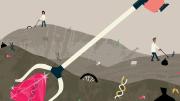Why pair up to procreate? Biologists have long wondered why so many organisms go to so much trouble to create offspring, when asexual reproduction fulfills the evolutionary goal of passing on as many genes as possible to the next generation.
During the last century, scientists developed two main theories. The “Red Queen” hypothesis says that DNA-sharing, because it speeds up evolution, allows organisms to stay one step ahead of parasites and other pathogens by evolving to outsmart their attacks. (The phrase comes from the Red Queen’s remark in Through the Looking Glass: “Now here, you see, it takes all the running you can do, to keep in the same place.”) The second theory, “Plucking Rubies,” suggests that recombining genes in each generation preserves beneficial mutations; at the same time, harmful mutations are selected out of the gene pool.
Cabot associate professor of organismic and evolutionary biology Michael Desai has changed the conversation, becoming the first researcher to directly observe, at a molecular level, how sex provides an evolutionary advantage. He finds that natural selection does appear to pluck rubies, though in a more complex way than scientists originally proposed.
In findings published in Nature, Desai describes his studies of Saccharomyces cerevisiae: yeast used in beer- and wine-making that reproduce, conveniently, both asexually and sexually. “We can have genetically identical strains that are maintained in almost identical environments, the only difference being that one population periodically undergoes mating,” while the other is strictly asexual, he explains.
They faced one major complication: although S. cerevisiae can reproduce sexually, they almost always choose the asexual route. It took “a lot of coaxing,” Desai says. “The yeast actually don’t like to have sex in the lab.” He created a system to force one population to mate every 90 generations, by adding genes for antibiotic resistance to their DNA and prompting those genes to switch on only when genes for mating were active. Researchers subsequently exposed that population to antibiotics, which allowed them to kill any yeast that didn’t have sex.
Because S. cerevisiae reproduce quickly, it took Desai’s team just six months to produce 1,000 generations of both populations. Sequencing the yeast genes every 90 generations allowed them to track genetic mutations over time, and he and his team saw a clear advantage to mating. “We found that sexual populations of yeast adapt substantially faster, close to twice as fast as asexual populations, over a thousand generations of laboratory evolution,” Desai reports. They also learned a little about why: in the asexual yeast, beneficial mutations are less likely to “fix” (spread across the population) because the yeast compete and interfere with each other. “Many beneficial mutations are driven extinct by this competition,” he says. In contrast, mating yeast recombine deleterious mutations away and contribute different beneficial mutations, so positive attributes spread.
Desai’s team was also surprised by a striking new finding: a number of very harmful mutations in asexual yeast “hitchhiked” to subsequent generations alongside beneficial mutations. “These deleterious mutations spread through the population because they’re linked to beneficial mutations,” he explains. “The strength of this effect was stronger than theoretical work that we and other people have done would have predicted.” But in mating populations, recombination prevented those hitchhikers from fixing, confirming a version of the plucking rubies hypothesis.
Many questions remain. “These experiments don’t yet answer the question of why sex is so widespread,” Desai says—and future studies will need to consider its costs. “Obviously it’s quite expensive to maintain all the machinery and spend all the effort that’s required for sexual reproduction,” he says. “What still needs to be done is to weigh these advantages that we have demonstrated here against the potential costs.” Hoping to further clarify this key biological question, he’s planning new studies forcing sexual and asexual strains of yeast to compete against each other, to see which wins out.
“Our genomes are big and complicated, and there’s a lot going on, and natural selection is trying to do all of these things at once: it’s trying to keep the deleterious mutations out of our genomes and drive the beneficial mutations through the population,” Desai says. “Sex is a way of helping natural selection do more things at the same time. In a sense, it’s a way of helping evolution multitask.”








